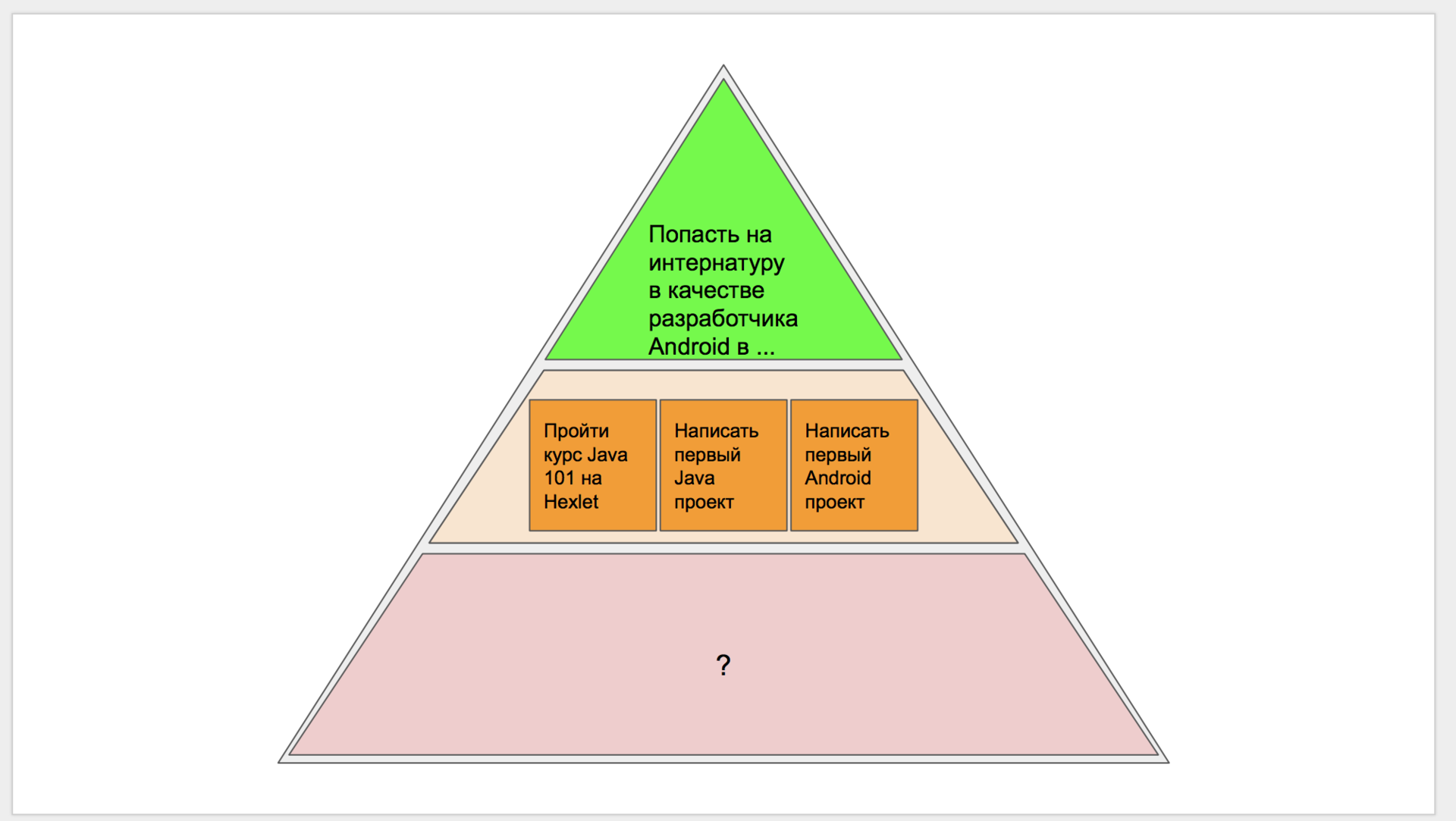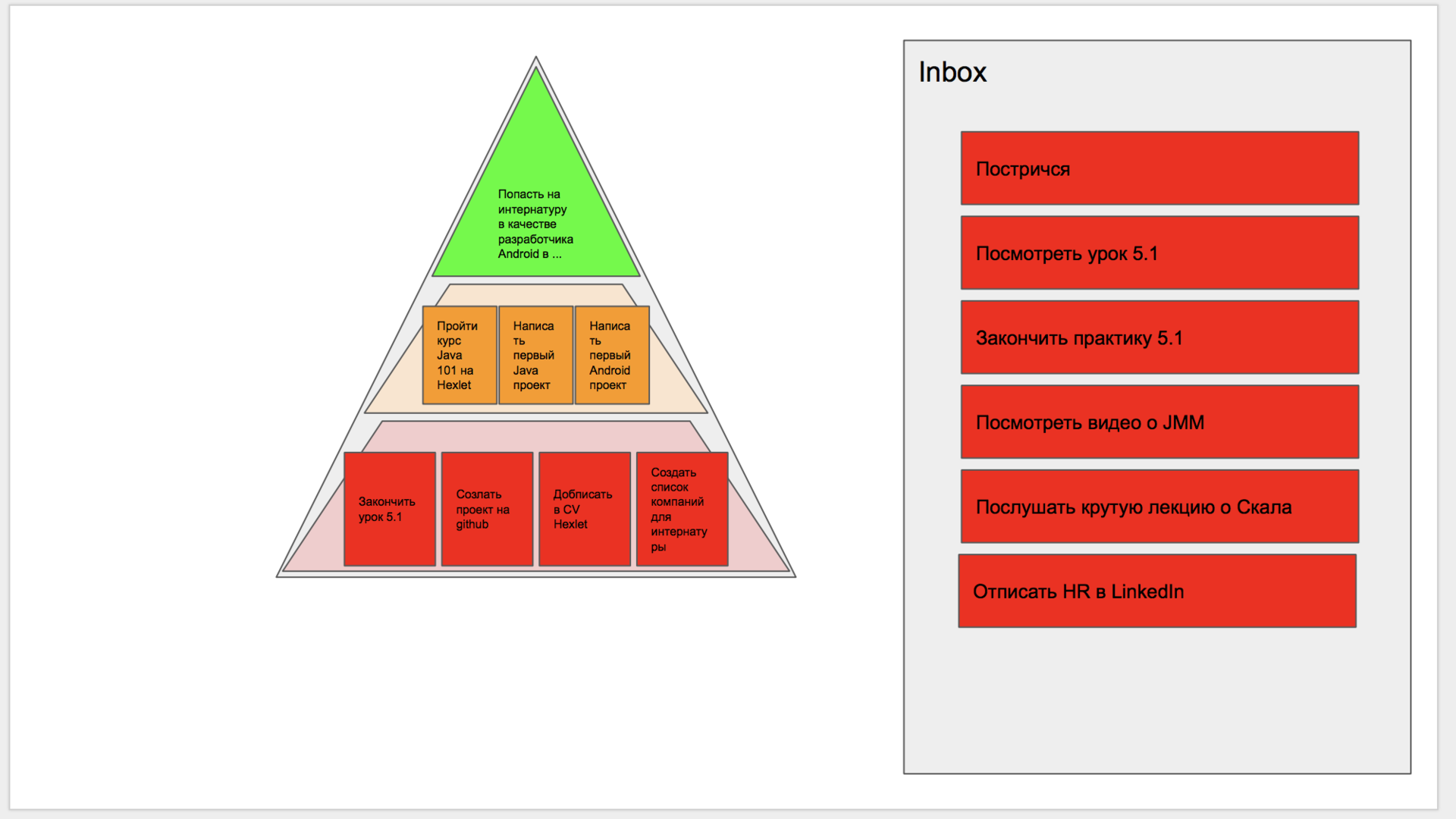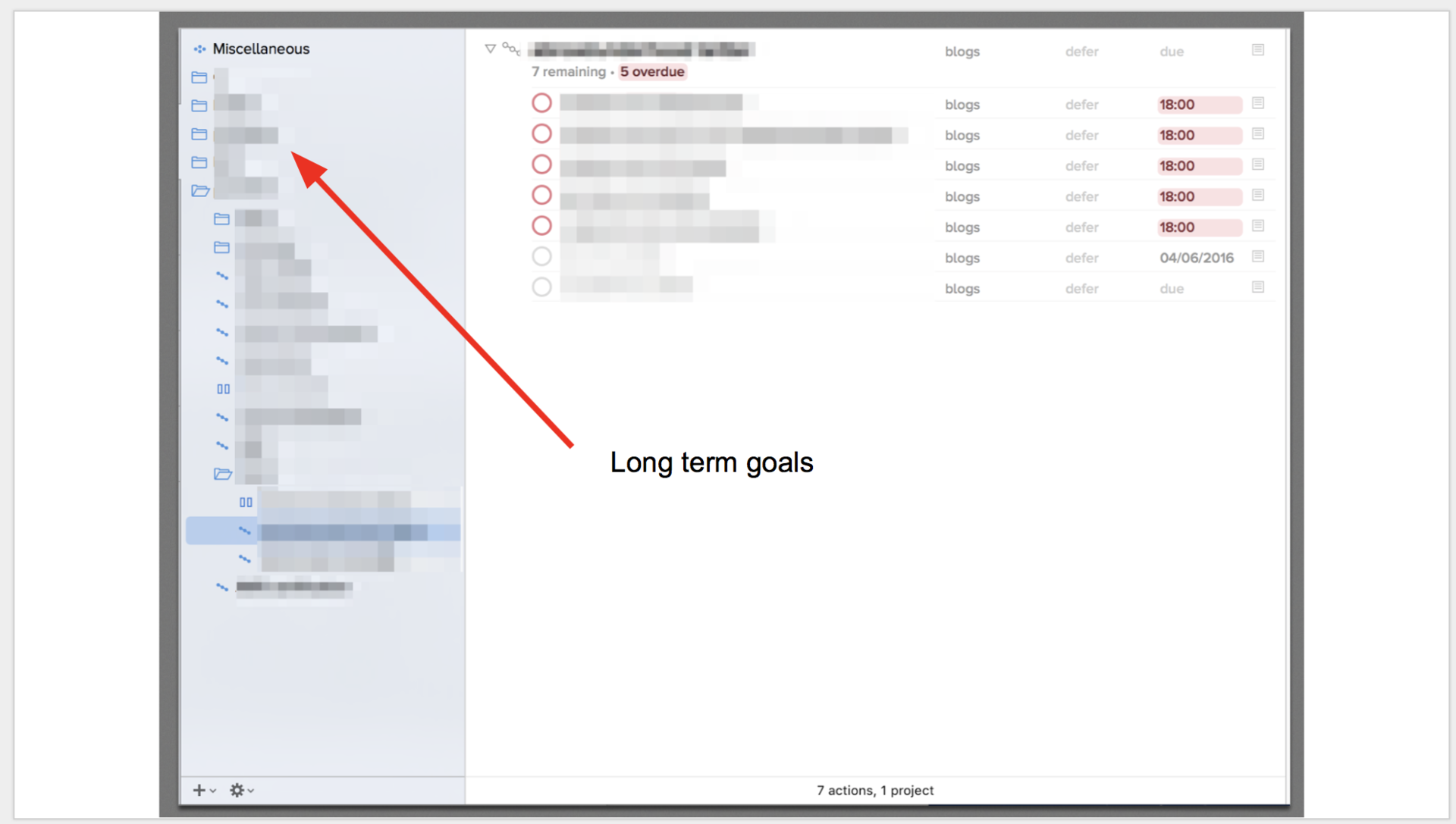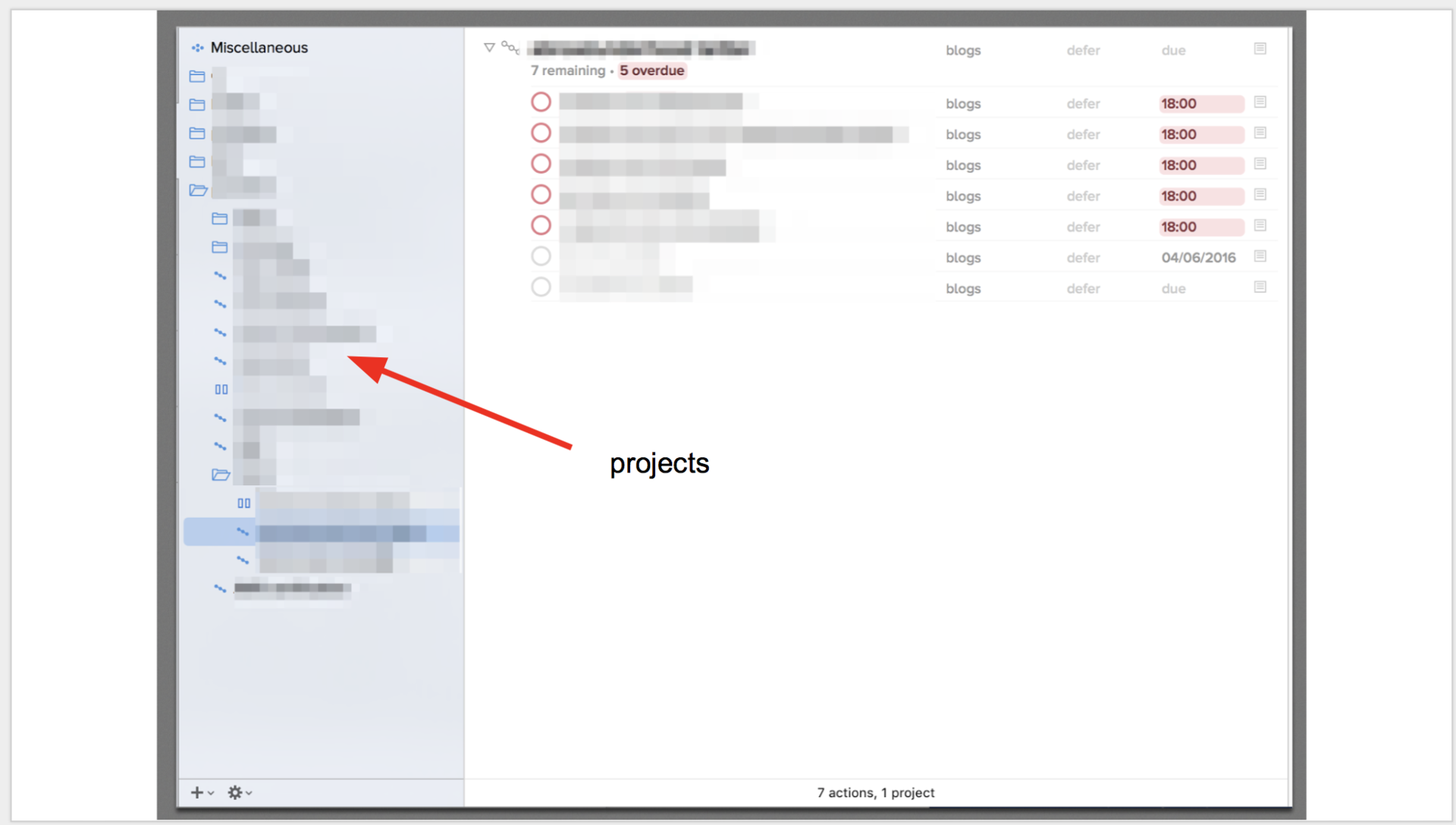How to complete long-term goals
This article is a continuation of the most important tips on improving productivity: "Personal productivity (only proven approaches)" .
In previous articles we talked about how to set long-term goals in the right direction - we call this the level of strategy. We have already talked about how to effectively carry out micromanagement of their tasks and bring the project to the end . Let's call this level tactical. Today I want to talk about how to properly connect these levels among themselves, so that what is being done at the tactical level is associated with the strategic level. Very often it is this aspect that podkashivaet young adherents of my advice. It seems that the productivity has grown and the long-term goals are right, but for some reason at the end of the quarter / year you realize that much less has been done than you would like. If this is familiar to you, then today I will tell why this is happening and how to deal with it.
For example, I took a VERY simplified case (personal long-time experience), which helped me find my first job in a large international company in the position of Android developer.
')
This article is based on the current screenshots of the Java Hexlet command , issue number 3 . Therefore, if you listened to a screencast, you can safely ignore the article.
To demonstrate the main ideas, I prepared a small presentation - this is how it turns out to be much more effective in showing the essence.
Conventionally, we depict our tasks in the form of a pyramid. It is very convenient. The more we talk about higher-level tasks, the fewer they are compared to low-level tasks.
Now let's look at how the pyramid of a healthy person and the pyramid of the smoker should look. First, take the example of a healthy person. Actually this will be the simplified pyramid of my goals many years ago, before I got a first job. Let's set the objectives (y) of the strategic level:

As I said, as a simplification, we take only one goal at this level, although in fact there may be more than one, but less than six. I can best set 3 goals. Next, we need to create long-term projects for the goal. I had to “think out” the projects (the old records were not preserved), because there were quite a lot of them then, like free time. The essence is not affected. Projects can be: “Java course”, “Java project”, “Android project”.

Sometimes you need to break one intermediate level task into sublevels. For example, the course can be divided into modules. I would have done so, but for now let's stop for the sake of explaining the material on this list. At the lowest level are tactical tasks - we set them for ourselves today. It is these tasks that come to us in quanta and are performed every day (we spoke about the "quanta" of time before ).

Let's go through the mistakes, namely, we look at the x-ray pyramid of the smoker. As a result, we will be able to better understand how your pyramid is "healthy" and how to eliminate the shortcomings, if any.
Error number 1
The biggest challenge is using non-SMART targets at any level, including the topmost level. The greatest harm this error brings when a non-SMART goal is set at the highest strategic level.
What is a SMART goal?
I singled out for you three aspects that I myself consider the most important. But let's move from theory to practice. I do not like to theorize, but I like to check for myself. Example:

Why is this goal not SMART? I can say exactly how many letters are in the word Android. Does this mean that I know him? Not? Why not? How can I understand from this goal that the ability to write the word “Android” is not its achievement? The only thing that this goal allows is to create “procrastinates”. These are goals created for procrastination. When the goal is unclear, your “procrastination machine” begins to choose targets from a list of those that are easiest to do. It is also completely unclear when this goal will be achieved, and accordingly it can be practiced forever (just a gift for procrastination). You can always push something important, arguing that there is another MEGA goal. For example, “I'd better teach Android, instead of preparing for the exam, because it really comes in handy”. I think all of you have friends who are always moving on to something. For example, dreamers to become “hackers” and others ... I had an acquaintance who came to my lectures and told me that he wanted to become a "hacker" and be able to do anything with his computer. He also fell asleep at a lecture on C ++ for beginners, citing the fact that he has such a defensive reaction to any material where you need to think a lot. So for the first time I saw a man who “turned off” if he needed to start thinking.
Error number 2
The second important mistake is a lie to yourself.

The lack of mid-level projects leads to the loss of the essence of the goal. This mistake is that tactical targets cannot be clearly linked to high-level targets. You can have a very good long-term goal, but by throwing yourself from head to toe with tactical tasks, you will stand still.
It is these people who always give advice: “you don’t need to work a lot, you need to work with your head.
Error number 3

It is not difficult to guess that the tactical level is one of those levels where it is easiest to spoil the process. For tactics is the main thing that each of us uses every day. You must understand that every hour of your time is not returned.
There is a term: “pinarik calendars”. This is the calendar where you mark your past and future years. Type this term in Google. You mark how much they lived and see how much time is left. If you want to make it really motivating, you can mark the approximate year of the end of the calendar. A terrible truth will open up before you - with every year you will have less and less opportunities. It's funny, but over the years you realize that almost your entire environment plays against you and your interests. But this can be discussed separately.
How to competently work with a HUGE list of what is trying to infiltrate the list of incoming tasks at the tactical level? Let's try to figure it out.
Suppose we have such input tasks (for example):

Having a clear idea of the three levels can work effectively on incoming tasks. Only in case you already have a normally structured pyramid. Immediately it becomes clear what project these tasks fall into. If the tasks did not fall into any of the projects, ask yourself whether it should be done and how urgent it is. There are no tasks of “medium urgency”, this is either an important task, or it will never be important, and there is no other (well, or this is procrastination). The task of “haircut” is important because it cannot be ignored forever. Moreover, you know for sure that she will not leave by herself - she needs to be taken and solved. If the task is not important for the workers / their projects, or for a pleasant leisure, then why are you considering this at all?
Quite simply, based on conscious priorities, correctly distribute the list of incoming tasks:

What works for me? In practice, for all my home projects, I use OmniFocus. I found a couple of screenshots on the Internet, which you and show you to understand how it looks.
Top daddies are long-term strategic projects:

Below are projects that themselves can be broken down into sub-projects. The pyramid may not necessarily be 3-level, although for a very long time I tried to keep it for myself within three levels:

The lowest level are those tactical tasks:

Controlling such a process, you are always ready to answer the question: “And what should I do today?”

The utility forces you to revise projects once a week to make sure that each of the projects is on a given course, or suddenly there are projects without tasks, or some projects need to be transferred to onhold, or, conversely, need to be removed from onhold.
Even with OmniFocus, I conduct an analysis of incoming tasks and monitor the state of “health” of my “pyramid”.
Not so much what program you choose (I recently used Things). The main thing is for you to understand after reading this article that the "pyramid" is not just a theory, it is a real practice.
And even if you do not want to take it, your tactical actions still lead you somewhere on a strategic level. The only question is who controls your future in 3-12 months: are you yourselves or complete chaos?
In previous articles we talked about how to set long-term goals in the right direction - we call this the level of strategy. We have already talked about how to effectively carry out micromanagement of their tasks and bring the project to the end . Let's call this level tactical. Today I want to talk about how to properly connect these levels among themselves, so that what is being done at the tactical level is associated with the strategic level. Very often it is this aspect that podkashivaet young adherents of my advice. It seems that the productivity has grown and the long-term goals are right, but for some reason at the end of the quarter / year you realize that much less has been done than you would like. If this is familiar to you, then today I will tell why this is happening and how to deal with it.
For example, I took a VERY simplified case (personal long-time experience), which helped me find my first job in a large international company in the position of Android developer.
')
This article is based on the current screenshots of the Java Hexlet command , issue number 3 . Therefore, if you listened to a screencast, you can safely ignore the article.
To demonstrate the main ideas, I prepared a small presentation - this is how it turns out to be much more effective in showing the essence.
Conventionally, we depict our tasks in the form of a pyramid. It is very convenient. The more we talk about higher-level tasks, the fewer they are compared to low-level tasks.
Now let's look at how the pyramid of a healthy person and the pyramid of the smoker should look. First, take the example of a healthy person. Actually this will be the simplified pyramid of my goals many years ago, before I got a first job. Let's set the objectives (y) of the strategic level:

As I said, as a simplification, we take only one goal at this level, although in fact there may be more than one, but less than six. I can best set 3 goals. Next, we need to create long-term projects for the goal. I had to “think out” the projects (the old records were not preserved), because there were quite a lot of them then, like free time. The essence is not affected. Projects can be: “Java course”, “Java project”, “Android project”.

Sometimes you need to break one intermediate level task into sublevels. For example, the course can be divided into modules. I would have done so, but for now let's stop for the sake of explaining the material on this list. At the lowest level are tactical tasks - we set them for ourselves today. It is these tasks that come to us in quanta and are performed every day (we spoke about the "quanta" of time before ).

Let's go through the mistakes, namely, we look at the x-ray pyramid of the smoker. As a result, we will be able to better understand how your pyramid is "healthy" and how to eliminate the shortcomings, if any.
Error number 1
The biggest challenge is using non-SMART targets at any level, including the topmost level. The greatest harm this error brings when a non-SMART goal is set at the highest strategic level.
What is a SMART goal?
- Specific - the goal must be specific, if two people understand it differently, then this is a bad goal;
- Measurable - the result of the goal must be clearly measurable;
- Attainable
- Realistic
- Timely - goal fulfillment must be within a specific time frame;
I singled out for you three aspects that I myself consider the most important. But let's move from theory to practice. I do not like to theorize, but I like to check for myself. Example:

Why is this goal not SMART? I can say exactly how many letters are in the word Android. Does this mean that I know him? Not? Why not? How can I understand from this goal that the ability to write the word “Android” is not its achievement? The only thing that this goal allows is to create “procrastinates”. These are goals created for procrastination. When the goal is unclear, your “procrastination machine” begins to choose targets from a list of those that are easiest to do. It is also completely unclear when this goal will be achieved, and accordingly it can be practiced forever (just a gift for procrastination). You can always push something important, arguing that there is another MEGA goal. For example, “I'd better teach Android, instead of preparing for the exam, because it really comes in handy”. I think all of you have friends who are always moving on to something. For example, dreamers to become “hackers” and others ... I had an acquaintance who came to my lectures and told me that he wanted to become a "hacker" and be able to do anything with his computer. He also fell asleep at a lecture on C ++ for beginners, citing the fact that he has such a defensive reaction to any material where you need to think a lot. So for the first time I saw a man who “turned off” if he needed to start thinking.
Error number 2
The second important mistake is a lie to yourself.

The lack of mid-level projects leads to the loss of the essence of the goal. This mistake is that tactical targets cannot be clearly linked to high-level targets. You can have a very good long-term goal, but by throwing yourself from head to toe with tactical tasks, you will stand still.
It is these people who always give advice: “you don’t need to work a lot, you need to work with your head.
Error number 3

It is not difficult to guess that the tactical level is one of those levels where it is easiest to spoil the process. For tactics is the main thing that each of us uses every day. You must understand that every hour of your time is not returned.
There is a term: “pinarik calendars”. This is the calendar where you mark your past and future years. Type this term in Google. You mark how much they lived and see how much time is left. If you want to make it really motivating, you can mark the approximate year of the end of the calendar. A terrible truth will open up before you - with every year you will have less and less opportunities. It's funny, but over the years you realize that almost your entire environment plays against you and your interests. But this can be discussed separately.
How to competently work with a HUGE list of what is trying to infiltrate the list of incoming tasks at the tactical level? Let's try to figure it out.
Suppose we have such input tasks (for example):

Having a clear idea of the three levels can work effectively on incoming tasks. Only in case you already have a normally structured pyramid. Immediately it becomes clear what project these tasks fall into. If the tasks did not fall into any of the projects, ask yourself whether it should be done and how urgent it is. There are no tasks of “medium urgency”, this is either an important task, or it will never be important, and there is no other (well, or this is procrastination). The task of “haircut” is important because it cannot be ignored forever. Moreover, you know for sure that she will not leave by herself - she needs to be taken and solved. If the task is not important for the workers / their projects, or for a pleasant leisure, then why are you considering this at all?
Quite simply, based on conscious priorities, correctly distribute the list of incoming tasks:

What works for me? In practice, for all my home projects, I use OmniFocus. I found a couple of screenshots on the Internet, which you and show you to understand how it looks.
Top daddies are long-term strategic projects:

Below are projects that themselves can be broken down into sub-projects. The pyramid may not necessarily be 3-level, although for a very long time I tried to keep it for myself within three levels:

The lowest level are those tactical tasks:

Controlling such a process, you are always ready to answer the question: “And what should I do today?”

The utility forces you to revise projects once a week to make sure that each of the projects is on a given course, or suddenly there are projects without tasks, or some projects need to be transferred to onhold, or, conversely, need to be removed from onhold.
Even with OmniFocus, I conduct an analysis of incoming tasks and monitor the state of “health” of my “pyramid”.
Not so much what program you choose (I recently used Things). The main thing is for you to understand after reading this article that the "pyramid" is not just a theory, it is a real practice.
And even if you do not want to take it, your tactical actions still lead you somewhere on a strategic level. The only question is who controls your future in 3-12 months: are you yourselves or complete chaos?
Source: https://habr.com/ru/post/301658/
All Articles